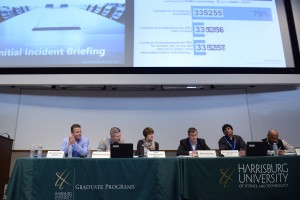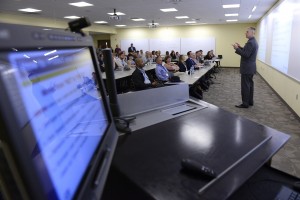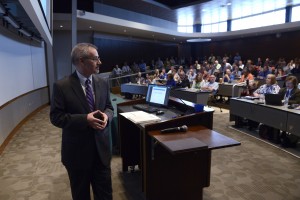
Seminar Schedule 2017
The PA TechCon 2017 event will be hosted on Thursday May 4, 2017 at Harrisburg University. This year’s annual event for our IT practitioners is themed around innovation and will have five tracks of parallel sessions. Each track consists of four independent 45-minute sessions providing attendees with the flexibility of switching tracks over the course of the day to attend sessions that are of the most interest.
Each track has a designated Commonwealth Track Owner responsible for working with the selected session vendors to provide guidance on the objectives of the session as well as review and provide feedback on the draft session materials. The track owner will attend all sessions in the track, introduce speakers, facilitate Q&A sessions, and moderate panels as needed.



Security Track
The Security track is designed to provide IT practitioners with insight into the direction the industry is heading and how to deal with operational challenges in the security space.
Session 1:
Securing Sensitive Data: Database Protection and Encryption Methods
Objective: The security threat landscape has changed dramatically. Commonwealth IT practitioners attending this session will receive valuable insight on best practices in securing sensitive data, particularly focused on Database Protection and Encryption Method
Session 2:
Applying Risk Management Practices (Impacts of Implementing or Not Implementing)
Objective: Research has proven over and over again that project performance could be improved considerably through the use of Risk Management. Commonwealth IT practitioners attending this session will receive valuable insight on designing a comprehensive framework to guide your information security risk management program, taking steps to enhance information security risk management, and using tools that drive strategic risk discussions and investment decisions
Session 3:
SECURITY DATA ANALYTICS AS A GUIDE FOR INTRUDER HUNTING
Objective: Illustrate how Security Data Science can support the gamut of security driven events into meaningful information “for the business.” Learn how to manage effective reporting to provide value to management to make better business decisions via an Intruder Hunting Program that gives insight into the most critical security issues within the organization. The session will cover the following topics:
- Initiating an Intruder Hunting Program
- Defining the “HuntScape”
- Automated and Manual Analysis Datasets
- Collection of Data and Data Reduction Rules
- Deriving Threat Intelligence from Reduced and Correlated DataSets
- Operationalizing Intruder Hunting
Session 4
Case Studies in Internal Security Threats
Objective: Ask most computer pros to talk about IT security, and you’ll likely hear about all sorts of external threats, like malware, hackers, spyware, DOS attacks and the like. But what if the bigger – and more costly – threat comes from within? Internal users are our first lines of defense and first lines of weakness. Internal users that perform careless actions, become compromised or have malicious intent put enterprise data at risk. Detecting inappropriate or abusive access to data is challenging without the right tools in place. Discussion topics will include case study examples, lessons learned, and application of control methods to combat this growing threat.
Application Development Track
The Application Development track is designed to provide IT practitioners with a well-rounded perspective on challenges like legacy modernization and ensuring application security, and a view into responsive design. This track takes you through the journey of legacy modernization, providing insight on current, innovative approaches to efficient product delivery, providing insight on the target state of technology and getting there safely.
Session 1:
LEGACY MODERNIZATION – SHOW RESULTS WHILE YOU MODERNIZE
Objective: The CIO today is being asked to modernize their legacy IT business systems to allow for easier access to data, to be able to react more quickly to changing user needs and demands, yet at the same time, reduce the overall IT spend. They are now faced with the daunting task of modernizing their legacy IT systems, while making whole sale, full replacements to these systems could pose immense program, operational and brand challenges. We will provide techniques for calculated modernization and bringing systems (and people) into current, supportable technologies, while avoiding key pitfalls.
Format: Single professional speaker that possesses significant experience in agile business system modernization arena.
Session 2:
Responsive Design – Taking it with You
Objective: To educate commonwealth IT practitioners on designing applications for a mobile workforce, the differences between responsive design and mobile apps, and the design of products, devices, and services for people who experience disabilities. Discussion topics are to include requirement characteristics that will determine if/when an application needs to be responsive, developing for cross-platforms, and accessibility.
Format: Moderated panel with pre-identified questions. Panel comprised of the following experience:
- An individual that can speak about responsive design experience with public facing website.
- Cross-Platform – an experienced vendor that can speak about the multiple platforms of designing application services for cross-platforms including multiple browsers (i.e. Internet Explorer, Google Chrome, Safari), different hand-held devices (i.e. Apple IOS, Samsung, etc.), and mobile workforces.
- Someone to speak about the IT accessibility factor.
- A person with a disability (i.e. visually impaired) to share personal perspective and drive home to the audience the criticality of accessibility (what it is like to be in his/her shoes).
- Moderator: a professional moderator with responsive design knowledge.
Session 3:
DEVOPS AND THE CLOUD
Objective: DevOps is a topic on the forefront of many IT groups as a means of increasing quality and shortening time to production. All with the end goal of delivering greater quality to end users in a quick and more repeatable manner. DevOps itself requires not just development but all parts of IT working together towards a common goal, a better experience for end users.
Format: Single professional speaker that possesses significant experience in the ALM and Application Development arena.
Session 4:
OPEN GOVERNMENT – BALANCING SECURITY AND INNOVATION WITH OPEN SOURCE SOFTWARE
Objective: Open source software is important – so important that the Federal Government recently created the Federal Source Code Policy to Achieving Efficiency, Transparency, and Innovation through Reusable and Open Source Software. But as adoption of open source grows within government, there are considerations to be made when selecting the right solution for your agency. This session will examine the benefits to open source such as the ability to quickly innovate, prevent vendor lock-in and substantially reduce costs. We will also review the need for commercially-supported open source to reduce risk and maintain a high level of security while receiving the flexibility of an open architecture. Attendees will leave this session with an understanding of why government agencies are using open source for large and small applications and what solutions can be used for state strategic initiatives such as cloud and mobile application enablement.
Format: Single professional speaker that will review case studies from state agencies in North Carolina and Maryland and answer questions from the audience.
Project Management Track
This year’s Project Management track will consist of interactive, workshop based sessions. The sessions are designed to focus on challenges for technical practitioners that are often wearing the hat of Project Manager through experiential learning.
Workshop 1:
How can I track project health/status in an Agile environment?
Overview: More and more agencies across the commonwealth are beginning to leverage the Agile methodology to take advantage of the benefits, like improved visibility by working closely with the business and improved quality because of frequent reviews of what is being developed are just a couple of the examples of those benefits. But the challenges are being able to identify a completion date and knowing whether or not the project is on track. When leveraging the waterfall methodology, requirements would be defined up front so project managers have a good sense of the scope of the project and in most cases can develop a pretty accurate completion date. In an Agile environment, since all of the requirements are not defined up front and changes are a part of the process, it is often difficult to answer those questions. However, executives are still asking the questions, when will the project or product be delivered and are we on track?
Objective: This will be a collaborative session to discuss how the agencies that are using Agile track project health/status. We will have 2 agencies and a vendor to talk about the tools and techniques they use to answer the questions about their projects being on track and how they answer the question, when the project will be completed? One of the groups will show either a mocked up project or real project and walk through each of the components they use to track the backlog, changes to the backlog, identify what they use to show a completion date, etc. The attendees will then have an opportunity to ask questions.
Format: Interactive workshop. We suggest having 2 agencies and a vendor involved.
Workshop 2:
Best Practice Techniques for Managing Your Vendor Relationships
Overview: The relationships that we maintain with our vendors are extremely important and are imperative to the success of our projects. There are often instances when communications and other important factors break down and can directly impact project success rates. What can we do to improve this moving forward?
Objective: To educate commonwealth project managers on the importance of maintaining positive relationships with our vendors and business partners and what to do in a case where the vendor is not meeting defined expectations. Have a presenter, who is a representative from the vendor community provide an overview as to why this topic is so important to both parties. They will then introduce a scenario where the vendor is not performing as defined in the contract. The attendees will work in teams of 5-6 to develop a series of questions that they feel would help resolve the issue. A representative from the vendor community would then join each table where the attendees would present their questions to them. The vendor representative would provide the attendees with honest feedback and would provide guidance on how to adjust their questions to ensure they are getting their point across, but do it in a professional manner to maintain a positive relationship
Format: Interactive workshop.
Workshop 3:
Improving Project Estimates and Communication
Overview: As project managers, we are asked at very early stages to provide project estimates for both cost and duration. In many cases, this occurs prior to any requirements being defined. What tools and techniques are available to help us generate better estimates and how do we set expectations with key stakeholders at the beginning and during our projects?
Objective: Provide an overview of some of the best practice tools and techniques for developing project estimates. This will include referencing the estimation toolkit that is available on IT Central. Discuss techniques to communicate early rough order of magnitude estimates to key stakeholders to ensure there is an understanding that the initial estimates may change as more information is gathered. The attendees will then work in teams of 5-6 and will first review a series of scenarios. Each scenario will provide a level of detail for a basic project, one that everyone can understand, like building a bike. One scenario will provide very little information, like build a bike. Another example will define some basic requirements, like the bike needs to be painted, needs to have 10 decals, needs to have custom chrome spokes, etc. A third example will provide all activities. The attendees will be asked as a team to create an estimate based on the information that was provided. The team will then be asked to present the estimate back to the executive. Each table would have a member of the vendor community asking questions about when they think the project would be complete, and ask the attendees how comfortable they are with meeting the expected date.
Format: Interactive Workshop. The vendor community will help facilitate the discussion and will provide an individual that would sit at each table that would represent that executive.
Workshop 4:
Developing a Simple, One-Page Business Case
Overview: Projects are often times initiated without a formal review and approval process. Many times these projects do not align with the Enterprise or agency’s strategic vision. There are also cases where new projects are initiated, but resources are not available or are taken off existing, in flight projects and moved to the new projects. This creates a scenario where the agency has a many active projects and they have difficulty closing them out.
Objective: The speaker will talk about the importance of the business case and the components that make up a good business case. The speaker will provide an example of a very simple, one-page business case (example includes the Lean Canvas). The speaker will then hand out a series of project overviews (3-4) to the attendees. Example projects would include one that makes sense and aligns to the agency’s strategic vision, where resources are available. Another would be a project that makes sense, but resources are not available. Another example would include a project that does not make sense, does not align to the Enterprise or agency strategic vision. The attendees will get together at their tables and review the project overviews and based on the information, they would work on completing the one-page business case for their projects. Because of the short time, maybe some of template is already completed. There would be a representative from the vendor community that would represent the agency executive sitting at each table. The attendees would then present their recommendations to the executive based on their findings. The executive would provide guidance as needed.
Format: Interactive Session
Telecomm/Infrastructure Track
The Telecomm/Infrastructure track will focus on how to leverage technology to improve personal productivity, enable our mobile workforce, develop a cloud strategy at the agency level and preview the exciting changes coming with Software Defined Networking.
Session 1:
Developing an Agency Cloud Strategy
Overview: Reveal how cloud solutions can optimize services and transform government to provide an improved experience for constituents and employees alike. Speaker(s) may discuss potential advantages and hurdles to implementation, budget impact, considerations, and trade-offs. Highlight the innovation and agility achieved by moving to the cloud.
Session 2:
Office 365 & How it will Change the Way We Work
Overview: To educate commonwealth IT practitioners on the capabilities of the O365 suite of tools and how to apply them to empower the workforce. Through the presentation of use cases and best practices, illustrate the benefits O365 brings to government. Highlight features such as Skype for Business, OneDrive, SharePoint and what that means for collaboration, document management, and program area innovation and how it aligns with our strategic plan.
Session 3:
Strategies to Enable a Mobile Workforce
Overview: For many commonwealth workers, the days of sitting behind the same desk in the same office is a vestige of the past. Our technology needs to evolve to support teleworking and home-based staff, agency workers and senior management who travel from site to site to perform their duties and continuity of our business in the event of a disruption as a few examples. This session is designed to demonstrate how technology can support the gamut of mobile users within the commonwealth. Discussion topics may cover methods of communication, collaboration, governance, management and deployment strategies for end user hardware, support models, and user connectivity. From an HR perspective tips for managers and employees to best leverage the technology for productive outcomes.
Session 4
How Software Defined Networking (SDN) Will Change the Commonwealth
Overview: Can you imagine a data center without network cables? Software Defined Networking changes the data center paradigm of a tangled mess of networking cables connecting systems to massive enterprise core switches with hundreds of ports. The objective of this session is to explain the impact SDN will have on commonwealth networking in the future environment and the capability, flexibility, agility, security ramifications, and potential cost savings SND will provide.
Agency Spotlight Track
The Agency Spotlight track will focus on how Commonwealth Agencies have successfully overcome IT challenges encountered and creatively implemented evolutionary solutions.
Sessions
Vendor support for this track is to be determined


